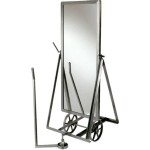Framing A Bathroom Mirror With Glass Tile: A Detailed Guide
Framing a bathroom mirror with glass tile is a project that can significantly enhance the aesthetic appeal of a bathroom. It transforms a plain, functional mirror into a decorative focal point, adding texture, color, and personality to the space. This detailed guide outlines the process, considerations, and best practices for successfully framing a bathroom mirror with glass tile.
Before embarking on this project, careful planning is essential. This includes selecting the appropriate materials, accurately measuring the mirror and surrounding area, and choosing a suitable design that complements the existing bathroom décor. Neglecting these preliminary steps can lead to complications and unsatisfactory results.
The primary considerations revolve around the tile selection, the adhesive to be used, the method of cutting and placing the tiles, and ensuring a clean and professional finish. Each of these aspects requires careful attention to detail and adherence to best practices.
Key Point 1: Selecting the Right Glass Tile
Choosing the right glass tile is paramount to achieving the desired aesthetic and ensuring the longevity of the framed mirror. Various factors contribute to this selection process, including size, color, finish, and style. The chosen tile should complement the bathroom's existing color scheme and overall design.
Size and Shape: Glass tiles are available in a wide array of sizes, from small mosaics to larger rectangular or square tiles. The size of the tile will influence the overall look and feel of the framed mirror. Smaller tiles create a more intricate and detailed design, while larger tiles offer a more streamlined and modern appearance. Consider the size of the mirror itself and the available space around it when choosing the tile size. For smaller bathrooms, smaller tiles may be more suitable to avoid overwhelming the space.
The shape of the tile is equally important. Square and rectangular tiles are the most common, offering clean lines and a contemporary feel. However, other shapes, such as hexagonal, round, or even irregular shapes, can add a unique and artistic touch. Consider the overall design of the bathroom and choose a tile shape that complements the existing aesthetic.
Color and Finish: The color and finish of the glass tile are crucial for establishing the desired mood and atmosphere within the bathroom. Glass tiles are available in a seemingly endless range of colors, from neutral tones to vibrant hues.
Neutral colors, such as white, beige, and gray, offer a timeless and versatile option that can blend seamlessly with any bathroom décor. These colors create a sense of calm and serenity, making them ideal for creating a relaxing spa-like atmosphere. Vibrant colors, such as blue, green, or red, can add a pop of personality and energy to the space. However, it is important to use vibrant colors sparingly to avoid overwhelming the room.
The finish of the glass tile can also significantly impact the overall look and feel of the framed mirror. Glossy tiles reflect light, creating a brighter and more spacious feel. Matte tiles offer a more subtle and understated look, providing a softer and more muted appearance.
Style: The style of the glass tile should align with the overall design of the bathroom. For a modern bathroom, consider sleek, minimalist tiles with clean lines and neutral colors. For a more traditional bathroom, consider ornate or decorative tiles with intricate patterns or textures. Mosaic tiles can add a touch of artistry and visual interest to any bathroom style.
Quality: When selecting glass tile, it is important to choose high-quality materials from a reputable supplier. High-quality glass tiles are more durable and resistant to moisture and staining, ensuring the longevity of the framed mirror. Consider the thickness of the tile, as thicker tiles are generally more durable and less prone to chipping or cracking.
Prior to purchasing a large quantity of glass tile, it is advisable to obtain samples to assess their suitability for the project. This allows for a proper evaluation of the color, texture, and overall appearance of the tile within the context of the bathroom’s lighting and décor.
Key Point 2: Preparing the Mirror and Surrounding Area
Proper preparation of the mirror and the surrounding area is essential for a successful and long-lasting installation. This involves cleaning the mirror surface, ensuring a stable base for the tile, and protecting the surrounding surfaces from adhesive and grout.
Cleaning the Mirror: The first step is to thoroughly clean the mirror surface. Use a glass cleaner and a lint-free cloth to remove any dirt, dust, or fingerprints. This ensures that the adhesive will properly bond to the mirror surface. Avoid using abrasive cleaners, as these can scratch the glass.
Creating a Stable Base: Depending on the mounting method, it might be necessary to create a border or frame around the mirror to provide a stable base for the tiles. This could involve using wood strips or a similar material to create a raised edge around the mirror. The material should be securely attached to the wall and should be able to support the weight of the tiles. If the mirror is already mounted flush against the wall, it may be necessary to use a strong adhesive specifically designed for bonding glass to the wall surface.
Protecting Surrounding Surfaces: Before beginning the tiling process, protect the surrounding surfaces from adhesive and grout. Use painter's tape and plastic sheeting to cover the walls, countertops, and any other surfaces that could be exposed to spills or splatters. This will make cleanup much easier and will prevent any damage to the surrounding areas.
Planning the Layout: Before applying any adhesive, dry-fit the tiles around the mirror to ensure a proper layout and spacing. This allows for adjustments to be made as needed and helps to visualize the final outcome. Pay attention to the corners and edges, and make any necessary cuts or adjustments to ensure a clean and professional finish. Use tile spacers to maintain consistent spacing between the tiles.
Ensuring Proper Ventilation: When working with adhesives and grout, ensure proper ventilation in the bathroom. Open windows or use a fan to circulate air and minimize exposure to fumes. Wear a respirator or mask to protect your respiratory system from dust and fumes.
Gathering Necessary Tools: Before starting the installation process, gather all the necessary tools and materials. This includes the glass tiles, adhesive, grout, tile spacers, tile cutter, trowel, grout float, sponge, bucket, and safety glasses. Having all the tools and materials readily available will streamline the process and prevent unnecessary delays.
Key Point 3: Applying the Adhesive and Grout
The application of the adhesive and grout is a critical step in framing a bathroom mirror with glass tile. The correct adhesive ensures a strong and durable bond between the tiles and the mirror, while the grout fills the gaps between the tiles, creating a waterproof and aesthetically pleasing finish.
Choosing the Right Adhesive: Select an adhesive that is specifically designed for bonding glass to glass or glass to other surfaces. This type of adhesive is typically a clear or translucent formula that will not be visible through the glass tiles. Follow the manufacturer's instructions carefully when applying the adhesive.
Applying the Adhesive: Using a notched trowel, apply a thin, even layer of adhesive to the back of each tile. Press the tile firmly onto the mirror surface, ensuring that it is properly aligned with the surrounding tiles. Use tile spacers to maintain consistent spacing between the tiles. Remove any excess adhesive immediately with a damp cloth.
Allowing the Adhesive to Cure: Allow the adhesive to cure completely before applying the grout. The curing time will vary depending on the type of adhesive used, so refer to the manufacturer's instructions for specific recommendations. Avoid disturbing the tiles during the curing process to ensure a strong and durable bond.
Selecting the Right Grout: Choose a grout that is appropriate for glass tile. Epoxy grout is a popular option, as it is waterproof, stain-resistant, and easy to clean. Sanded grout is another option, but it is important to use a fine-sanded grout to avoid scratching the glass tiles. Select a grout color that complements the tile color and the overall design of the bathroom.
Applying the Grout: Using a grout float, apply the grout to the gaps between the tiles. Work the grout into the gaps, ensuring that they are completely filled. Remove any excess grout immediately with a damp sponge. Rinse the sponge frequently to prevent grout from drying on the tile surface.
Allowing the Grout to Cure: Allow the grout to cure completely before cleaning the tile surface. The curing time will vary depending on the type of grout used, so refer to the manufacturer's instructions for specific recommendations. After the grout has cured, use a clean, damp cloth to remove any remaining grout haze from the tile surface.
Sealing the Grout: To protect the grout from moisture and staining, apply a grout sealer. Follow the manufacturer's instructions carefully when applying the sealer. Reapply the sealer periodically to maintain its effectiveness.
Final Touches: Once the adhesive and grout have fully cured, inspect the framed mirror for any imperfections. Touch up any areas as needed and clean the entire surface with a glass cleaner. The newly framed mirror should now significantly enhance the bathroom's aesthetic.

Diy Mirror Frame With Glass Mosaic Tile Armchair Builder Blog Build Renovate Repair Your Own Home Save Money As An Owner

Diy Mosaic Tile Bathroom Mirror Centsational Style

Diy Mosaic Tile Bathroom Mirror Centsational Style

Diy Mosaic Tile Bathroom Mirror Centsational Style

Simple Ways To Make A Framed Bathroom Mirror Hometalk

Diy Mosaic Tile Bathroom Mirror Centsational Style

Bathroom Mirror Frames Ideas 3 Major Ways We Bet You Didn T Know Mirrors Can Transform Your Decor Around The World

Diy Mosaic Wood Tile Mirror Frame Addicted 2 Decorating

Not Sure What To Do With Those Extra Tiles Now Collecting Dust There 39 S More Bathroom Mirror Makeover Frames Trendy Vanity

Diy Mirror Frame With Glass Mosaic Tile Armchair Builder Blog Build Renovate Repair Your Own Home Save Money As An Owner








